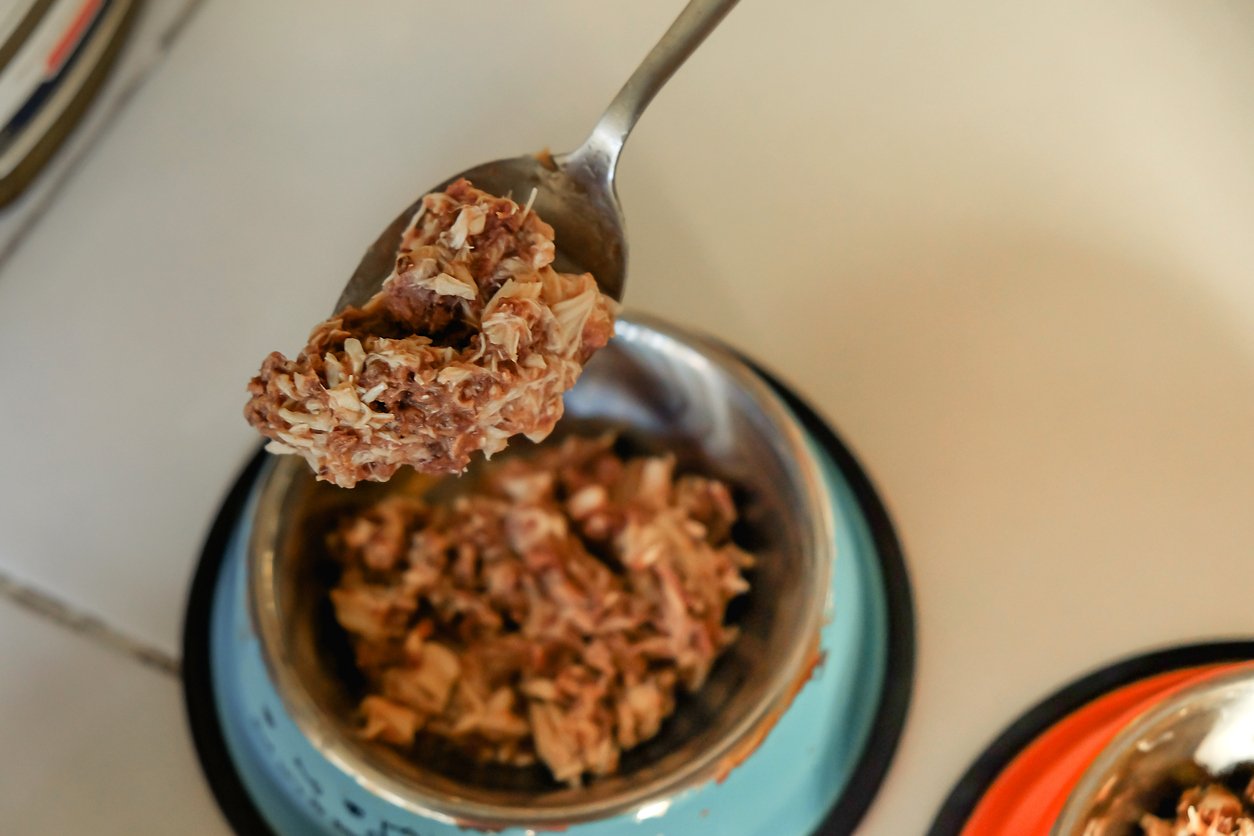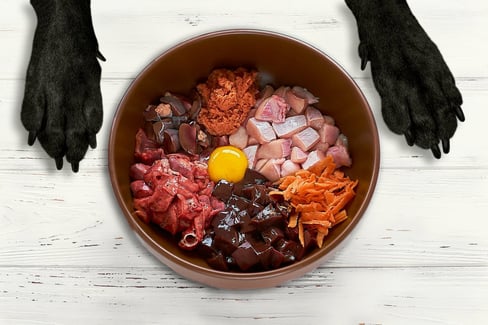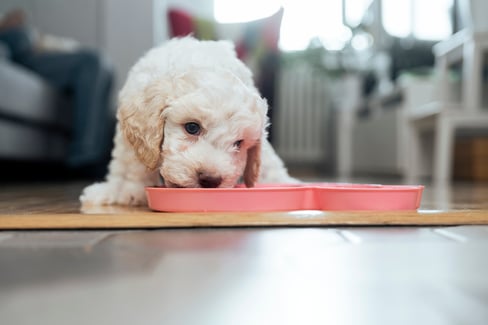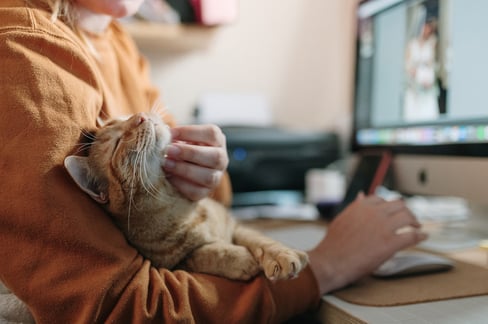Table of Contents
If you’re reading this post, you’re probably trying to find the best way to support your cat’s health through their diet.
Just like for humans, diet trends come and go for our feline friends. One trend that has been around since the mid-90s? The cat raw food diet.
But what’s just hype, and what’s actually the best option for your kitty?
In this post, we’re going to cover everything you need to know about whether or not choosing a cat raw food diet is the right choice for your furry companion, as well as some of the pros and cons of other kinds of cat food diets.
We’ll also cover the history of raw cat food, and uncover the reasons it has become so popular. Before we get to that, we need to get to explaining what exactly raw cat food is.
Feeding your feline a raw cat food diet means that you are feeding them, well, raw food.
This includes items like:
- Raw animal muscle meat
- Raw animal organ meat
- Ground bones from animals
- Other protein-rich ingredients like fish and eggs
So if you’ve been trying to find the purr-fect meal for your cat, and are curious about raw cat food, read on to find out more about this interesting diet.
Brief History of Raw Cat Food
If we look back in history, both felines and canines were catching their own dinner at some point.
Nowadays, cats might bring you a mouse on occasion but mostly this wildness has been domesticated out of our pets. For some owners, harkening back to the olden days is the option they look to for keeping their cat healthy.
In the 1990s, people started talking about the idea of a raw cat food diet, and by the early aughts, the desire for more natural products for our pets became increasingly popular.
This was a far departure from the ways humans from the middle ages to the mid-19th century fed their pets. At that time, humans were sparing what they could for their pets, including scraps of meat, bones and vegetables. By the time the mid-1800s rolled around, veterinary nutrition science was evolving and so was human understanding of what our beloved furry companions should be eating for dinner.
With an understanding of how to feed pets coming into focus, humans were able to develop the first dog biscuit in the 1860s, with those recipes paving the way for commercially made cat food in the latter part of the century. From there, wet foods also became available for cats in the 1930s. This was not only convenient, but by the time the 1950s rolled around, ads were already touting the benefits of canned food for cats — just check out this newspaper advertisement below!
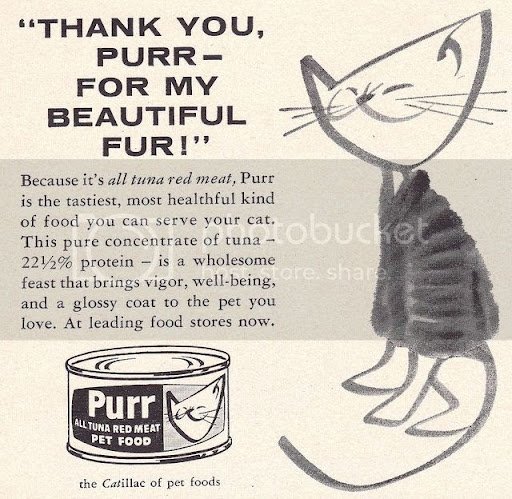
Flash forward to today and most pet stores have aisles of options for cat food, treats, and supplements.
The Popularity of Raw Cat Food in North America
Raw cat food, which is part of the broader natural pet food category, has only risen in popularity since its initial introduction a few decades ago.
In fact, the natural pet food market reached a value of over $22.8 billion in 2020.
Now that’s a lot of cat treats!
We know that we aren’t feeding our beloved pets horse meat or sketchy scraps anymore, but that doesn’t mean pet paw-rents are totally safe from dangerous pet food. In fact, that could be seen as one of the biggest reasons cat owners might switch to a raw cat food diet.
Sadly, in 2007, there was a huge recall on certain commercial pet foods because they contained melamine (which is a very toxic industrial chemical — yuck). Thousands of cats (and dogs) got sick or died from consuming this toxic food.
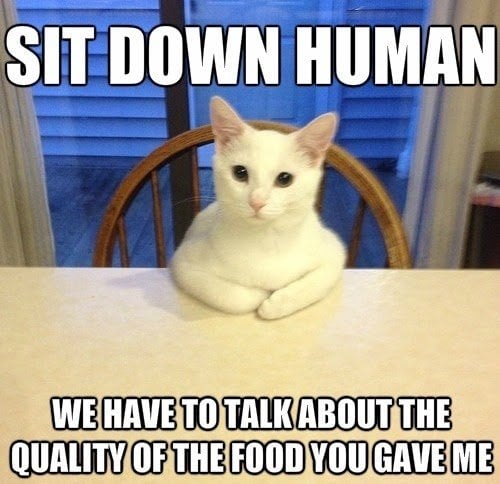
With this (and other recalls) pet owners might start to feel like they are safer to make their own cat food than trust a manufacturer.
This kind of anti “Big Pet Food” sentiment is really just a psychological response from us as humans. But what exactly do we mean by that?
Basically, as humans caring for our pets, we want them to be healthy and happy. And sometimes, a method to care for your cat that is simple to DIY and easy to understand is more preferential than, say, heading to a vet or choosing a food that is manufactured.
Just like a well-intentioned but overbearing parent, sometimes pet owners feel they know best —even if it turns out their cat may not be suited to a raw cat food diet in the first place.
The Advantages of Raw Cat Food
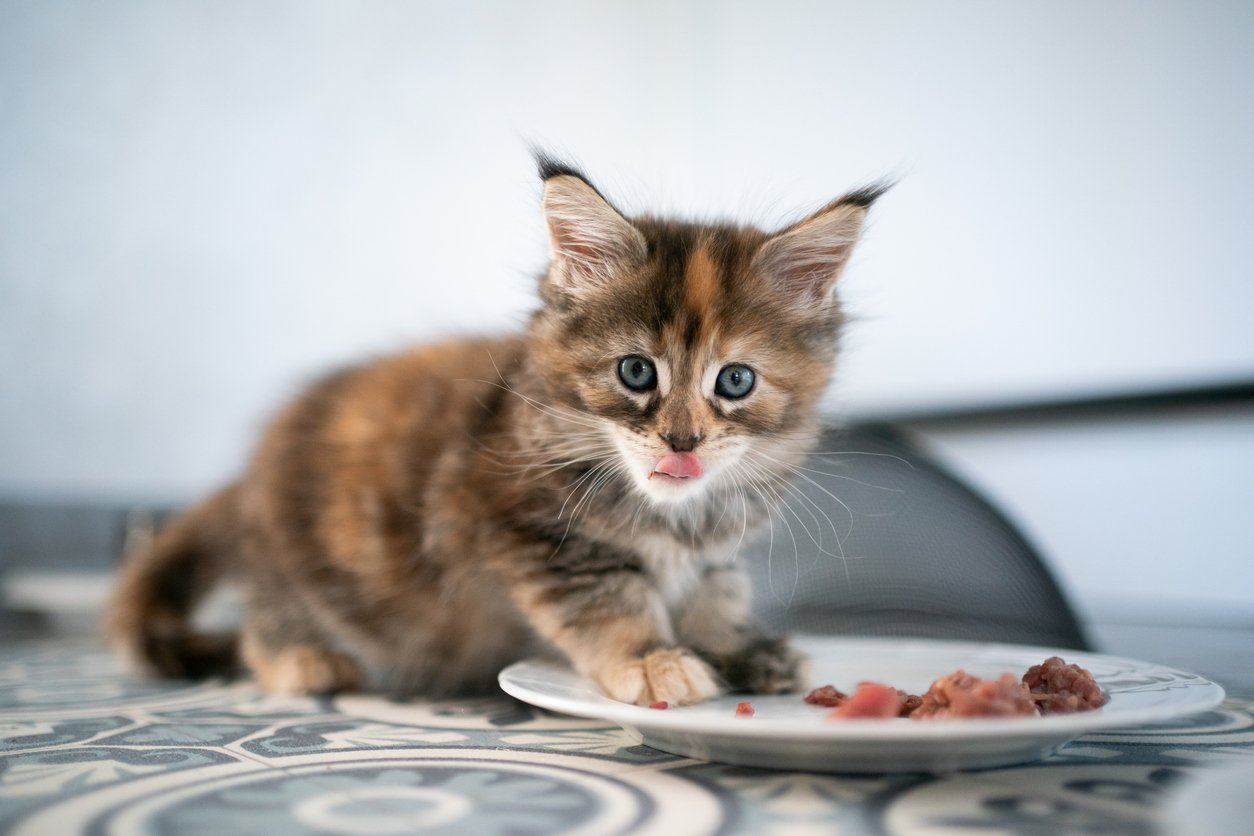
Here’s the thing.
There’s a lot of evidence that raw cat food is the best way for your cat to stay healthy, but it is either scientifically unsupported or hasn’t been researched enough to really be sure of the benefits of this diet. However, there are plenty of cat owners that feel that raw cat food diets are the way to go. Many owners have been able to help ageing or sick kitties find a new lease on life with raw cat food diets.
So let’s get into the advantages we can see that feeding a cat raw food diet may have:
| Advantages of Raw Cat Food | Key Benefits |
| Highly Customizable | By implementing a raw cat food diet, you are able to customize flavours your cat will love and also ensure you can switch it up often to prevent your cat from getting bored. |
| Simple to Supplement | It’s easier to add (and hide) supplements to raw cat food diets when needed. For instance, our TRI-ACTA for Pets is a great proactive option for keeping your cat’s joints healthy as they age with two forms of glucosamine, lab-sourced chondroitin and MSM. If your kitty is in their senior years, TRI-ACTA H.A. for Pets, offers all the goodness of our regular strength formula with the addition of hyaluronic acid for maximum joint mobility. |
| Bring Out Their Wild Side | Cats were once hunters searching for their own dinner. By choosing a diet that closely mimics that of what cats would find in the wild, you’re not only appealing to their taste buds but also their natural instincts. |
| Quality Control | Since you’re preparing the raw cat food yourself, you can control what goes into it. You can select the highest quality organic meat or fish and ensure your pet is not getting a bowl full of fillers or dangerous chemicals like melamine. |
4 The Disadvantages of Raw Cat Food
Now that we’ve covered a few of the advantages of trying a cat raw food diet, you probably want to know what the drawbacks are, too.
Let’s get into them so you can better understand the dangers that could await you if you choose to try this special diet for your pet.
1. Risks of Bacterial Contamination
Salmonella. Listeria. E.coli.
Few words can make a consumer more nervous than those.
When preparing a raw cat food diet, there are risks for both pets and humans in the house. As humans, we cook our food to reduce our risk of consuming deadly pathogens.
Unfortunately, the whole premise of a raw food diet is that the food is raw, and these dangerous pathogens tend to thrive in raw meat. Salmonella, listeria, and E.coli may remain on surfaces, dishes, in your cat’s waste, and even on them (particularly around the mouth) if they consume affected meat. Simply put —giving your kitty some snuggles and touching their face after they try a cat raw food diet could land you in the hospital, not to mention what it could do to them!
The scary things potentially lurking in raw meat you’re hoping to feed your cat don’t stop there.
Zoonotic disease transmission, also known as animal to human transmission, includes terrifying sounding parasites like Toxoplasma gondii and Echinococcus tapeworms. They can be passed from cat to human as cats may not seem or be affected, and can again contaminate the environment or humans in their environment.
The bacterial contamination risks are particularly serious if elderly persons, children or pregnant women are in the home.
We can’t stress enough how dangerous these pathogens can be, so consider that before you consider a cat raw food diet for your beloved kitty.
2. Risk of Nutritional Deficiency
Your cat needs a variety of vitamins and minerals in its diet.
Since they are obligate carnivores, they need nutrients that are only found in other animals’ flesh. That sounds simple enough, right?
Not quite! Cats need a careful balance of the following nutrients in their food’s formulation:
- Vitamins
- Amino Acids found in fish & meat (like arginine and taurine)
- Minerals
- Fish & Meat Protein
- Fatty Acids
There can be some scary repercussions if you don’t balance what they need in their raw cat food diet.
For example, arginine helps rid the body of ammonia through urine. When cats don’t get enough, a toxic buildup of ammonia can occur.
Not to mention, cats don’t need carbohydrates and vegetables in their diets, so while it’s ok for a little wheat, rice, or corn to get into their food when it’s cooked in, they don’t truly benefit from it.
Manufactured cat food offers carefully formulated blends of these key nutrients that can be hard to measure for a home cook trying a cat food raw diet.
3. Specific & Challenging Process
Think of how many tools exist in a large-scale production facility for processing raw cat food.
Now think about scaling that to your kitchen!
You will need to invest in the proper materials to get the job done including:
- Poultry shears
- Meat grinders
- Cutting boards and mixing bowls (not the same tools humans in the house are using for their food)
- Storage (both containers and the freezer space)
- Preferably prepared in a contained area of the home to reduce pathogen transmission
Consider you’ll have to regularly undertake the process of finding high-quality meat to buy, processing raw meat, parboiling it, shredding it, freezing it…the list goes on and on.
This is a valuable time investment for some, but if you already have a busy life and don’t want to hire a personal chef for your kitty, a raw cat food diet may not be the choice for you.
It’s not as simple as running to the store to pick up a can or bag of cat food!
4. Proper Storage of Food
You might assume that since it’s essentially raw meat, raw cat food needs to be properly stored.
If your cat won’t be consuming its homemade dishes within 2 days of preparation, freezing is essential. Using small containers so the food freezes quickly and evenly to eliminate the chances of food-borne illness for your kitty is key.
Also, unless you’re thinking of serving a popsicle for your cat’s dinner, defrosting your raw cat food would also be essential. In this situation, there is again a risk of food-borne illness.
Imagine you have a forgetful cat sitter unfamiliar with your safe cat food handling processes, and they accidentally give your beloved furball 3-day old food, or forget to defrost it on time?
That would not be good.
As you can see, there’s a lot of opportunities for dangerous bacteria to harm your pet in almost all aspects of food preparation, so safe food handling is really your ticket to safety if you choose to introduce your pet to raw cat food.
Pros and Cons of Alternative Options to Raw Cat Food
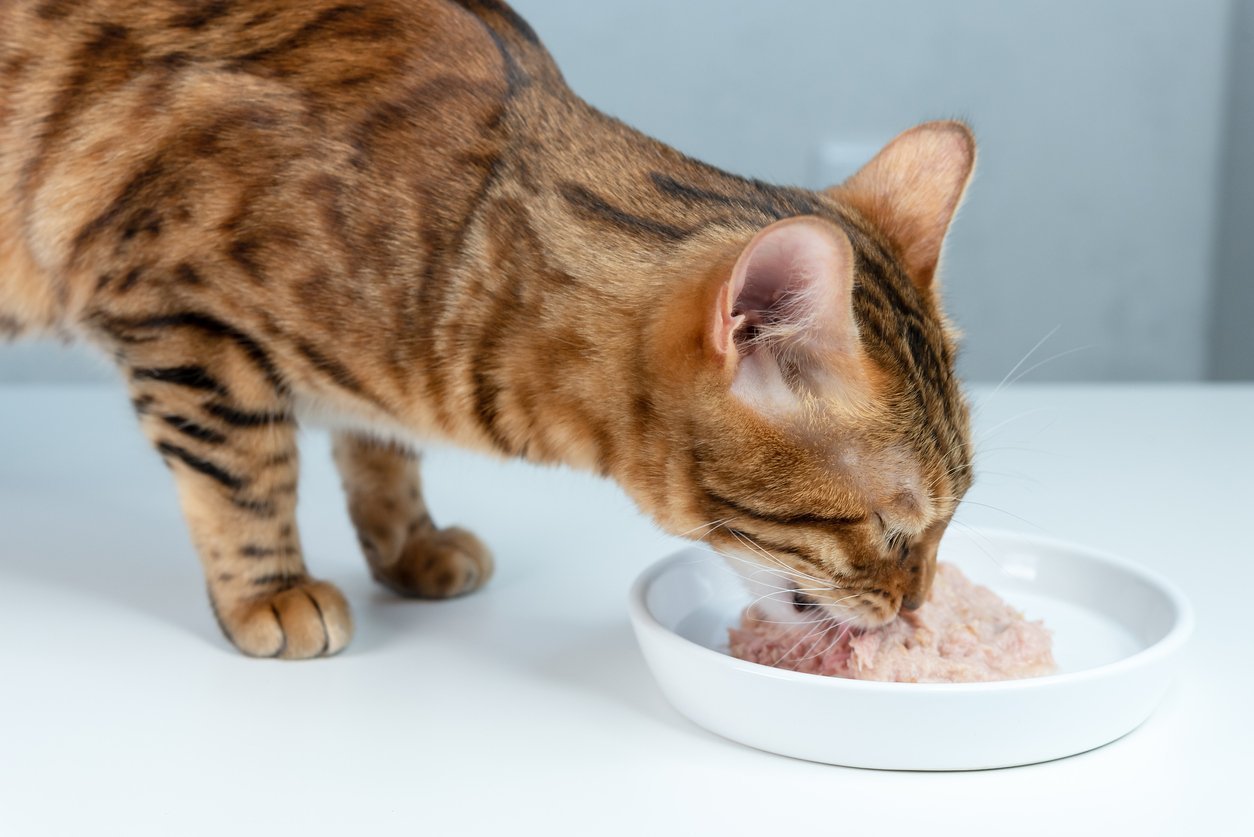
If the challenges and risks of trying a cat raw food diet have you feeling more than a little nervous, we get it.
Maybe instead you’d like to consider another option for your cat’s healthiest diet, but you want to make sure it’s the best one for their needs and your lifestyle.
In this section, we’re going to break down the three primary kinds of cat foods available today:
- Dry Kibble
- Wet Food
- Semi-Moist Food (also known as “pouch food”)
That way, you can make the best decision about your cat’s health, and whether a cat raw food diet is the ideal choice for them.
Dry Kibble for Cats
First up, we’ve got dry kibble. This dry, hard form of cat nutrition has been a conveniently available staple for years.
And that’s just one pro. It’s also got a long shelf life that makes it simpler to store, and a few other things that might make you consider buying dry kibble like:
- It’s typically a cost-effective price as you can buy in bulk quantities.
- Cats graze in the wild, and unlike wet foods or raw cat food, you can let your cat graze all day instinctively without worrying about it going off.
- Chewing dry kibble helps control plaque and tatar build-up for cats, and many kibbles are formulated with dental support as well.
While those are some pretty strong arguments in favour of dry kibble, there are definitely quite a few against it, too. Primarily, cat owners often say kitties turn their whiskers up at it and it’s just not as palatable for your cat like some other forms of nutrition.
There are other cons to think about, too, like:
- Buying kibble in bulk is a money saver, but if you don’t have the room to store it, the ability to buy it or don’t have funds upfront to buy such a large quantity, it’s probably not much of a deal.
- Bulk also means boredom for your cat. It’s been proven that pets prefer variety in their diets over repetition, so a huge bag that takes weeks or months to go through may not be ideal.
- Gastric emptying times may be longer in cats who eat kibble. That means that their feeling of fullness could be affected and it’s a better environment for hairballs to form, too.
Wet Cat Food
Next, we have what’s probably considered the best tasting (but definitely not the best smelling) cat food option. Wet cat food is generally the most appealing to cats because of its characteristics, like moisture, soft texture, and a stronger smell. But why else do felines love it?
Consider these reasons:
- Fewer carbohydrates than dry food mean fewer filler ingredients and more nutritional value in the meal.
- Easy to eat for felines with fewer or no teeth, making it great for supporting the health of elderly cats.
- Easier to give your medications or supplements to cats than in dry food.
One common reason cat owners don’t opt for wet food all the time is that it’s more expensive than dry kibble. It also requires refrigeration after opening, as well as covering, and can make for a stinky companion in the fridge next to your own food. Vegans and vegetarians, as well as Kosher homes, may not appreciate the meaty presence in their fridges.
Finally, wet food, just like raw cat food, can go bad if left at room temperature for too long. Ensuring you are able to feed your cat at mealtimes may not be possible for your schedule, plus you must clean the dish and remaining food up right away to again avoid making your cat sick.
Semi-Moist Cat Food (“Pouch Food”)
Finally, we have the hybrid of wet food and dry kibble. Semi-moist food, also known as “pouch food” is basically the TV dinner of the cat world.
While that sounds not so nice, semi-moist food is actually very palatable for cats due to the higher moisture content and stronger flavours over kibble. It also doesn’t require refrigeration to store, unlike wet cat food. It’s also easier to chew for senior cats or kittens who are transitioning to adulthood.
There are some cons to using this as the primary source of nutrition for your cat, including:
- It typically contains more artificial colours, flavours, sugar and salt than dry or wet cat food.
- It’s usually available in smaller packages designed for convenience, so it’s often more expensive than other food formats.
- It’s considered a convenience food for cats, making it less nutritious than other food for cats and more appropriate as an occasional treat.
How Supplements for Cats Help Maximize Benefits
This post has made it clear that there is no shortage of options to feed your cat. From wet to dry, raw cat food to cooked, cats these days have options.
No matter what you feed your cat, there’s always a bit more nutrition you can offer them by adding a supplement to their diet. Supplements can provide great health benefits to your cat.
You can pick up a cat supplement designed to help specific systems in their bodies, to help improve:
- Eyes
- Digestive health
- Joints
- Skin and fur
- Immune system
You can also pick up supplements that focus on helping your cat with a specific ailment, like our TRI-ACTA H.A. for pets, which is focused on helping manage cat arthritis, but we’ll get into that later.
So before you decide to change your pet’s diet too much, make sure you are able to find the right supplement to meet their nutritional needs and have a conversation with your vet about your cat’s specific health needs, and how that could be impacted by a raw cat food diet.
Popular Supplements Owners Provide with Raw Cat Food
There are three most popular raw cat food supplement options that could complement a raw cat food diet:
- Nutritional Supplement
- Mature Cat Supplement
- Joint Health Supplement
The three most commonly used kinds are outlined in the table below:
| Cat Supplement Type | Benefits |
| Nutritional Supplement | Especially in a raw cat food diet, it can be hard to make sure your cat is getting all the vitamins and minerals it needs, so choosing a nutritional supplement that adds things like Taurine, Thiamine, Niacin, Vitamin D, and Vitamin A back into their diet is something you should speak to your vet about if you think your kitty is missing some pep in their step. |
| Mature Cat Supplement | Diseases like arthritis, diabetes, kidney disease and obesity are common in senior cats. To ensure your cat is getting a balanced diet supportive of its senior needs, you will want to add things like extra calcium, magnesium and hyaluronic acid into their diets through supplements. |
| Joint Health Supplement | Making sure your cat’s joint health is fully supported is easy with the help of a cat joint supplement, which should include glucosamine, chondroitin and MSM for pets of all ages. Also consider products using 100% active ingredients, like TRI-ACTA for Pets, because nobody likes paying for filler products. |
How to Start Preventing Cat Joint Problems
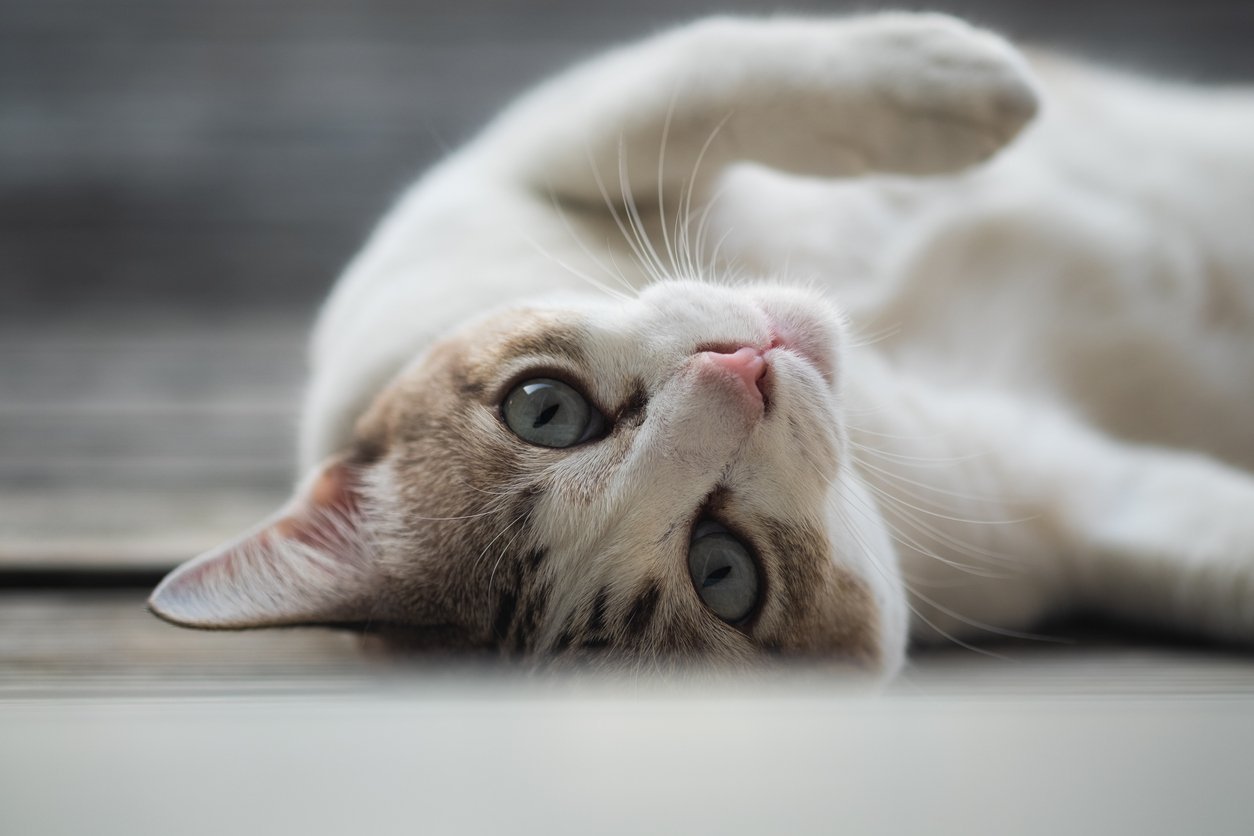
In this post, we’ve covered a lot of information about the raw cat food diet. We talked about everything from what the raw cat food diet entails, the history of raw cat food, as well as the advantages and disadvantages of cat raw food diets and the alternatives available to you as a pet parent.
We also made sure to discuss the raw cat food supplement options available so you can make sure your feline friend has the health support they need as they grow older.
One thing you can do today to make sure you’re preventing future cat joint problems for your kitty? Try out a joint health supplement, whether it’s Integricare’s TRI-ACTA & TRI-ACTA H.A. or another cat supplement on the market, and your cat will have a paw-sitive outlook on their golden years!
TRI-ACTA for Pets
A proactive approach for developing and younger adult pets to maintain optimal joint health mobility, minimize inflammation and fend off age-related ailments.
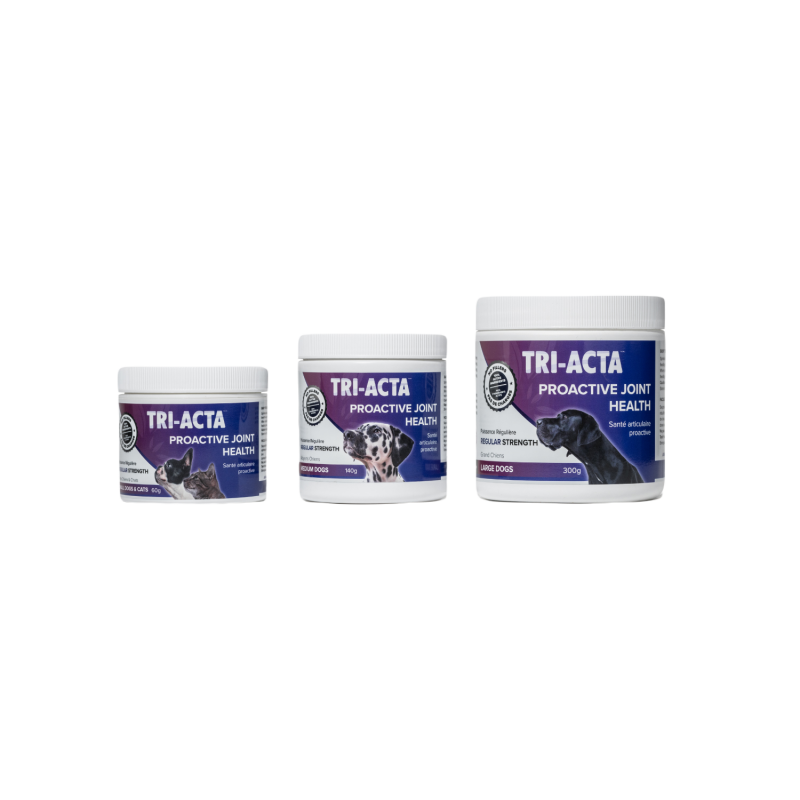
Newsletter Signup
Subscribe to our newsletter to receive the latest news and exclusive offers.
.jpg?height=2000&name=Cliick_Integricare-DISPLAY-REVISEDV2%20(1).jpg)
Proactive & Therapeutic Joint Supplements
When given daily, Integricare joint supplements recover bone and joint injuries faster and help prevent mobility injuries from happening in the first place.

